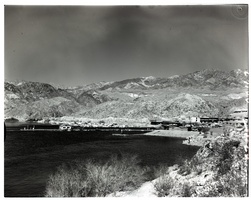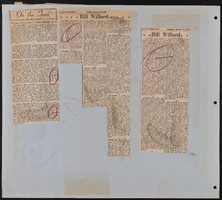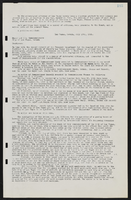Search the Special Collections and Archives Portal
Search Results

Transcript of interview with Dr. Holbert H. Hendrix by Keith Thomas, February 20, 1979
Date
Archival Collection
Description
On February 20, 1979, Keith Thomas interviewed Dr. Holbert H. Hendrix (born 1914 in French Lick, Indiana) about his life in early Las Vegas, Nevada. The interview takes place at the University of Nevada, Las Vegas in Room 312 of the Education Building. Dr. Hendrix first discusses his personal background and interests, as well as his occupational background in teaching. The two discuss changes at the University of Nevada, Las Vegas, including construction, when the university began awarding degrees, and Dr. Hendrix’s reasons for moving to Las Vegas. Dr. Hendrix then describes changes to the Strip and how the hotel industry has changed since he first arrived in Nevada. The two briefly discuss how problems with prostitution may have increased since Dr. Hendrix arrived in Nevada. The interview concludes with Dr. Hendrix contemplating new problems that may arise in Las Vegas as a result of an expected population boom and his hopes that the Nevada state government would invest more into funding for education.
Text
Kim Bird and Pam Fogliasso oral history interview
Identifier
Abstract
Oral history interview with Kim Bird and Pam Fogliasso conducted by Claytee D. White on February 08, 2013 for the Boyer Early Las Vegas Oral History Project. Bird and Fogliasso discuss their experiences growing up in Las Vegas, Nevada, segregation in the city, and their years attending Rancho High School, including the segregation.
Archival Collection
Emory Lockette Sr. oral history interview
Identifier
Abstract
Oral history interview with Emory Lockette Sr. conducted by Dennis McBride on March 17, 1996 for the Boulder City Library Oral History Project. In the interview, Lockette discusses his work as a draftsman, civil engineer, and hydraulics engineer for the Bureau of Reclamation. He then describes his working conditions at the Bureau of Reclamation and administrative-level conflicts.
Archival Collection

Film transparency of Willow Beach Marina, Arizona, 1972
Date
Archival Collection
Description
Image

Transcript of interview with Bill Armstrong by Anthony Robone, February 28, 1979
Date
Archival Collection
Description
Text
Roberta Kane oral history interview
Identifier
Abstract
Oral history interview with Roberta Kane conducted by Barbara Tabach on September 6, 2017 and May 22, 2018 for the Southern Nevada Jewish Heritage Project. Kane explains how she was the first born Jewish baby in Las Vegas, Nevada and her parents’ deep involvement with the Jewish community of the 1930s. She then talks about the formalization that occurred in the Jewish community with the building of Temple Beth Sholom. In a second session, Kane recalls the Wildcat Lair, a gathering spot of students from Las Vegas High School in the 1950s.
Archival Collection
Fyhen, Ragnald, 1884-1971
Ragnald “Rags” Fyhen was an original member of the Nevada Central Labor Council. He was a labor organizer in the Clark County area. Fyhen was born in Tromso, Norway on August 1, 1884.
Fyhen was a machinist by trade. He came to Clark County in 1934 to work on the Hoover Dam and founded the Central Labor Council with some colleagues, which was instrumental in negotiating the labor agreement with Six Companies, Inc. to complete the dam. He served as the secretary-treasurer for the Central Labor Council from 1934 to 1947.
Person

Transcript of interview with Neil Henry Holmes by James Greene, January 14, 1975
Date
Archival Collection
Description
On January 14, 1975, collector James Greene interviewed foreman, Neil H. Holmes (born on November 16th, 1897, in Chicopee, Kansas) in his home in Boulder City, Nevada. This interview covers the early days in Boulder City. Mr. Holmes also discusses the local education system, family life, employment opportunities, housing, and the building of Hoover Dam.
Text


